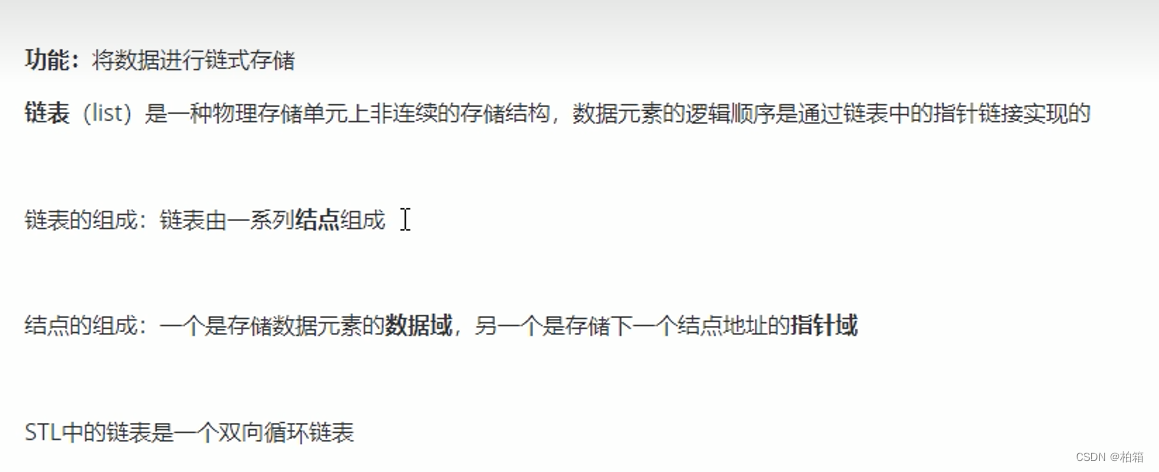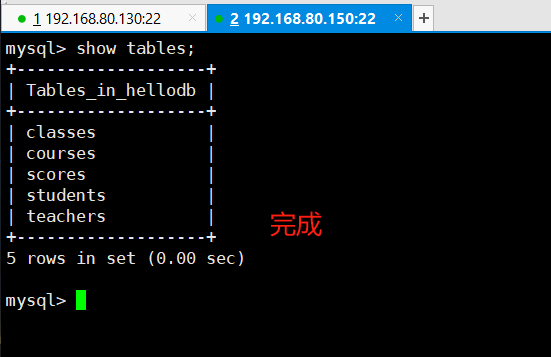目录
1.list基本概念
2.list构造函数
3.list的赋值和交换
4.list大小操作
5.list的插入的删除
6.list数据存取
7.list反转和排序
排序案例
1.list基本概念




2.list构造函数
#include<bits/stdc++.h>
using namespace std;
void print(const list<int> &lk)
{
for(list<int>::const_iterator it = lk.begin(); it != lk.end(); it++)
{
cout << *it << " ";
}
cout << endl;
}
int main()
{
list<int> lk1;
lk1.push_back(78);
lk1.push_back(98);
lk1.push_back(59);
print(lk1);
list<int>lk2(lk1.begin(),lk1.end());
print(lk2);
list<int>lk3(lk2);
print(lk3);
list<int>lk4(3,99);
print(lk4);
return 0;
}
3.list的赋值和交换

#include<bits/stdc++.h>
using namespace std;
void print(const list<int> &lk)
{
for(list<int>::const_iterator it = lk.begin(); it != lk.end(); it++)
{
cout << *it << " ";
}
cout << endl;
}
int main()
{
list<int> lk1;
lk1.push_back(78);
lk1.push_back(98);
lk1.push_back(59);
print(lk1);
list<int>lk2;
lk2 = lk1;
print(lk2);
list<int>lk3;
lk3.assign(lk2.begin(),lk2.end());
print(lk3);
list<int>lk4;
lk4.assign(3,999);
print(lk4);
cout << "交换前:lk3 ";
print(lk3);
lk3.swap(lk4);
cout << "交换后:lk3 ";
print(lk3);
return 0;
}
4.list大小操作
#include<bits/stdc++.h>
using namespace std;
void print(const list<int> &lk)
{
for(list<int>::const_iterator it = lk.begin(); it != lk.end(); it++)
{
cout << *it << " ";
}
cout << endl;
}
int main()
{
list<int> lk1;
lk1.push_back(78);
lk1.push_back(98);
lk1.push_back(59);
print(lk1);
cout << lk1.empty() << endl;
cout << lk1.size() << endl;
lk1.resize(5,100);
print(lk1);
//指定长度比原来长默认用0来填充
//指定长度比原来短会删除多余的部分
return 0;
} 
5.list的插入的删除

#include<bits/stdc++.h>
using namespace std;
void print(const list<int> &lk)
{
for(list<int>::const_iterator it = lk.begin(); it != lk.end(); it++)
{
cout << *it << " ";
}
cout << endl;
}
int main()
{
list<int> lk1;
lk1.push_back(78);
lk1.push_back(98);
lk1.push_back(59);
lk1.push_front(334);
lk1.push_front(45);
print(lk1);
lk1.pop_back();
print(lk1);
lk1.pop_front();
print(lk1);
list<int>::iterator it = lk1.begin();
it++;
lk1.insert(it,1000);
print(lk1);
lk1.erase(lk1.begin());
print(lk1);
lk1.push_back(78);
lk1.remove(78);
print(lk1);
//刪除所有的78
lk1.clear();
print(lk1);
cout << "結束" << endl;
return 0;
} 
6.list数据存取
#include<bits/stdc++.h>
using namespace std;
void print(const list<int> &lk)
{
for(list<int>::const_iterator it = lk.begin(); it != lk.end(); it++)
{
cout << *it << " ";
}
cout << endl;
}
int main()
{
list<int> lk1;
lk1.push_back(78);
lk1.push_back(98);
lk1.push_back(59);
lk1.push_front(334);
lk1.push_front(45);
print(lk1);
//不支持用[]和at方式訪問
//也不能用it = it + 1,但可以it++和it--
//因為不支持迭代器的隨機訪問
cout << lk1.front() << endl;
cout << lk1.back() << endl;
return 0;
} 
7.list反转和排序
#include<bits/stdc++.h>
using namespace std;
void print(const list<int> &lk)
{
for(list<int>::const_iterator it = lk.begin(); it != lk.end(); it++)
{
cout << *it << " ";
}
cout << endl;
}
bool cmp(int v1,int v2)
{
return v1 > v2;
//降序就讓第一個數大於第二個數
}
int main()
{
list<int> lk1;
lk1.push_back(78);
lk1.push_back(98);
lk1.push_back(59);
lk1.push_front(334);
lk1.push_front(45);
print(lk1);
lk1.reverse();
print(lk1);
//所有不支持隨機訪問迭代器的容器,不可以用標準算法
//它內部會提供算法
lk1.sort();
cout << "默認從小到大:" << endl;
print(lk1);
lk1.sort(cmp);
cout << "更改後變為從大到小:" << endl;
print(lk1);
return 0;
}
排序案例
#include<bits/stdc++.h>
using namespace std;
class person
{
public:
person(string name,int age,int height)
{
this -> name = name;
this -> age = age;
this -> height = height;
}
string name;
int age;
int height;
};
bool cmp(person &p1,person &p2)
{
if(p1.age == p2.age) return p1.height > p2.height;
else return p1.age < p2.age;
}
int main()
{
list<person> l;
person p1("熊貓",3,180);
person p2("企鵝",5,160);
person p3("老虎",3,200);
l.push_back(p1);
l.push_back(p2);
l.push_back(p3);
for(list<person>::iterator it = l.begin(); it != l.end(); it++)
{
//小括號這裡必須加
cout << (*it).name << ' ' << (*it).age << ' ' << (*it).height << endl;
}
cout << "排序後" << endl;
cout << "--------------------------" << endl;
l.sort(cmp);
//自定义数据类型必须指定排序规则
for(list<person>::iterator it = l.begin(); it != l.end(); it++)
{
//小括號這裡必須加
cout << (*it).name << ' ' << (*it).age << ' ' << (*it).height << endl;
}
return 0;
}
























